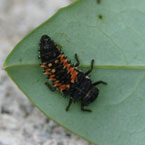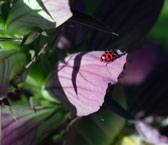home | fall garden | shade garden
Ladybug
Also known as ladybird beetles, ladybugs are among the most familiar beetles, easily recognized by their round spotted bodies. They are about 1/16th of an inch long with shiny red, orange, or yellow coloring and black markings. Their coloring is a defense mechanism that lets other predators know that they are bad tasting. Also, the adult ladybug will sometimes fall to the ground and "play dead" in order to avoid being eaten. There are over 6,000 species world-wide and 450 species in the United States. Ladybugs are among our most beneficial insects as they can consume 5,000 aphids and soft-bodied insects in their one year life-span. In the spring, adult females seek out aphid colonies and lay from 50 to 300 eggs among the aphids. Eggs are tiny and light yellow in color. Eggs hatch in 3 to 5 days, and the larvae will feed on aphids and other insects for 2 to 3 weeks before pupating. Shrimp-like pupa will then attach itself to a leaf and begin its transformation into a ladybug. Adults emerge in 7 to 10 days with a soft body that will harden within a few hours. In the fall, adults hibernate, sometimes in large numbers in plant refuse, crevices, and even houses.
 |
 |
 |
